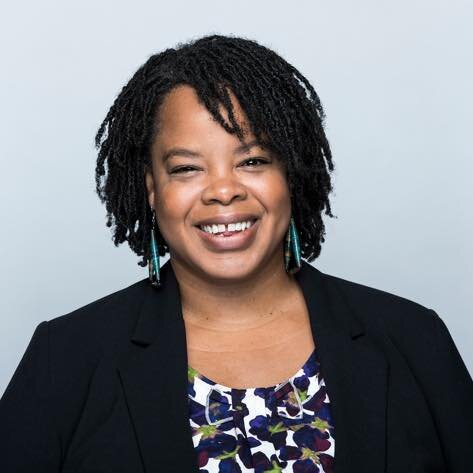Our Values: Achieving AUTHENTICITY By Listening
Tamisha Tyler
Tamisha A Tyler, MDiv (she/her) is Co-Executive Director of Art | Religion | Culture (ARC). A dynamic speaker and facilitator, she hosts workshops and discussion around diversity, community and art. She also works with several arts organizations and projects including Level Ground, New Story Festival, and serves as faculty at Grunewald Guild.
Take a deep breath.
Hold it…
…release.
Do that three more times before you return to your normal breath.
What do you hear?
The constant hum of the fan as it slices through the air in an attempt to cool your...breath?
(take another one…in...hold….out. Good)
The rumble of cars as they pass by outside? Or maybe the chime created by the collar on your pet as they make their way to you. Distinct voices engaging in indistinct conversations, background music, the taps of your keyboard, a heartbeat, your….breath…
Breathe in deep, from the belly. Hold it…
Release.
I go through this process a few times a day and lately I’ve noticed that in the pit of my stomach I feel a deep (dissatisfaction?). With every deep breath I take I’m trying to get to the bottom of it, to inhale in enough air to surround that anxiety and to exhale it once and for all, only to pause and feel it reform once more, like regrowing a hand after its been severed. I mean, shit, I can only meditate for so long.
I started meditating as a way to take a break from all that was going on in the world. There was so much noise, and if I was going to offer any contribution to create a better world, I needed to step away, recharge, and breathe. But that (uneasiness?) in the pit of my stomach led me to explore that there was more I needed to learn from meditating. I needed to learn to listen to myself.
Working in an arts non-profit, I understand the importance of sharing stories. It’s my job to create spaces for people to share their stories, and to engage with others in ways that honor storytelling. Listening plays a central role in this. A professor once told me that “leadership begins with listening” and I take that to heart. But in all of my work creating spaces for story-sharing and in being a leader who listens, I wasn’t listening to myself. Whenever I was irritated and unfocused, I blamed it on how much time I spent on social media. While part of that is true, if I’d taken the time to listen to myself I would’ve realized that I was pushing myself too hard, hadn’t had anything to eat or drink, and I needed fresh air. Listening to myself became a huge lesson I had to grasp, especially during quarantine.
In thinking about the values of listening, I had to wrestle with authenticity the most. Here is how we articulate authenticity:
“We seek appropriate transparency in our altruism, recognizing that trust is an investment, earned with openness and accountability.”
As I try to share about my journey in learning the lesson of listening, I want to focus on these three points. The first is seeking transparency. Now this may sound weird in thinking how to be transparent with myself, but it is harder than it sounds. Have you ever reflected on an incident and allowed yourself to feel all the feels, only to go back to it (sometimes years) later and realize that you never fully acknowledged what you were feeling? How that initial anger was really connected to a disappointment rooted in a narrative of “I’m not good enough?” Transparency with ourselves teaches us to lean into the fullness of our emotions and needs. It teaches us that our stories are complicated, there is always something under the surface for us to reflect upon.
The second concept is trust as an investment. Just as we engage in relationships that need to be built on trust, we are constantly learning to trust ourselves. How do you build trust with yourself? For me, it was learning to trust my intuition, or my gut. Whenever I felt like something was wrong or didn’t feel right, I trusted that feeling and stepped away from that thing. Likewise, whenever something felt good or I felt like I was going in a right direction, I practiced leaning into that feeling. I allowed myself to be excited over what I felt were good things, and honored my need to step away from not so good things. Was I always right? Well, I was right more than I was wrong. And because I was open to being transparent with what I really wanted, I trusted myself when I came to a decision. Each time I did, I gained more confidence.
Lastly is openness and accountability. Just because you are learning to listen to yourself, doesn’t mean that you are by yourself. Your community plays a key role in your process of listening to yourself. This can manifest in many ways. For me, it's having an A-Team (A is for Accountability). I have people who I trust on this journey to talk through what I am feeling and hearing in my own reflection, and who hold me accountable to what I have said and promised myself. They remind me that I am loved and supported, and also remind me that the negative stories I believe about myself are false. They help me to not create an echo chamber of my own thoughts, and to see beyond my blindspots. Through trusting them to help me listen to myself, I allow them to set the example of how to listen to others.
Over the last few months, meditating and breath work has become a little bit easier. That pit in my stomach (frustration?) wasn’t completely removed, but I learned that it was trying to tell me something, and I needed to listen. Creating the space where I could be heard helps me to understand the importance of honoring the voices and stories of others. The more I take the time to listen to myself, the better I become at listening.
Our “Listening Values” Campaign
Over the next five weeks, we will be opening our blog page to members of our local and national network to share their stories and perspectives on how the art and act of listening is seen in our values.



